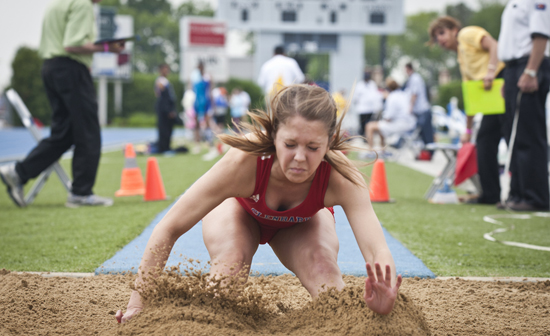For athletes, there is an inevitable truth that we all must face, no matter the level of competition or experience: athletes make mistakes. Mistakes may be embarrassing, disappointing or even painful, but there is a key to overcoming these challenges. We, as athletes, hold the power of choice. How we choose to respond in the face of failure is the secret to success.
Controllable vs. Uncontrollable
While there are many competitive factors that are out of our control as athletes, there are many that are within our control. For example, you can control your effort, time spent practicing or how you support teammates. However, you cannot control factors like the weather, your coach’s response, a referee’s decision or directly control the outcome of the game.
Breaking down a mistake into uncontrollables and controllables can help to reframe our mindset. An athlete’s time and energy is precious — it is simply not efficient to dwell over something that was out of our control in the first place. On the other hand, if we made a controllable mistake, it is best to acknowledge the incident and identify how to grow from it. How we choose to frame the next move or the next play is the most important part of the game. Famed UCLA basketball coach John Wooden once said, “Things turn out best for the people who make the best of the way things turn out.”
Activity: Try this after your next practice or game: List all of the mistakes or failures you believe you made. Now categorize them and place them into two boxes. Reviewing this after performances can help us gain perspective as athletes.
Developing Awareness
Many of us respond to mistakes in a negative manner. Athletes develop a self-dialogue during competition and many times respond harshly in the face of a mistake. For example, “I’m horrible at this game,” or “How could I miss such an easy shot? I stink.” This type of self -talk can create a self-fulfilling prophecy of failure. In many cases this type of thought response becomes habit.
Therefore, it is important to start with being aware of how you typically respond to making a mistake. Not only with self-talk but with emotions. Are you angry, disappointed, indifferent? Do you shut down or start blaming others after you make one mistake? How we feel has a direct impact on how we perform. Try to monitor your response in practice.
Be Proactive!
If we know that mistakes are inevitable then we can create a proactive game plan. Having a mistake recovery plan in advance will help you get back to the game or onto the next play successfully. Follow the five R’s to regain your focus and move forward with a positive mindset.
1) Recognize: Acknowledge your mistake both mechanically and how you respond mentally. Do not ignore the mistake. This is the time to learn and improve.
2) Rethink: Reframe all the negative thoughts that are going through your mind with productive, positive, and instructional thoughts.
3) Release: Let go! You have to release the mistake. Holding onto the mistake and the negative thoughts will only keep your head in the past and not on the present moment.
4) Relax: Take three deep breaths. Your body and mind are connected. Your body may respond to a mistake with muscle tension. Use deep breathing to signal your body to release the mistake and move forward.
5) Refocus: Now it’s time to bring your attention to the present moment. Many athletes use cue words such as “reset” or “right here, right now.”
Takeaway Skill:
In a game you only have seconds to react to a mistake. Therefore, we must practice the five R’s in advance. Just as you would not go out and run a marathon without training, the same goes for mental skills. The five R’s will not work automatically in a game, so below is an exercise for athletes to try beforehand.
Activity: Imagery is a tool that helps the mind train without the body working physically. This type of rehearsal is important as you can properly walk through a mistake and your desired reaction in your own time. With practice this response will become routine and therefore get you back in the game quicker.
1) Close your eyes and envision yourself in your game. You can visualize yourself as you would see it through your own eyes or as if you are watching videotape.
2.) Think about a mistake that you commonly make and visualize yourself making that mistake during the next play.
3.) Using the five R’s, correct your mistake through the process and achieve your desired reaction and outcome. Be clear and concise in each step.
4.) Follow this plan and practice routinely.
Kat Scardino, M.Ed. and Devin Markle, Co-Directors of Athlete Development at Sports Academy, are members of the WSF Digital Contribution Team.
The content provided for this article has been approved by the Women’s Sports Foundation.

